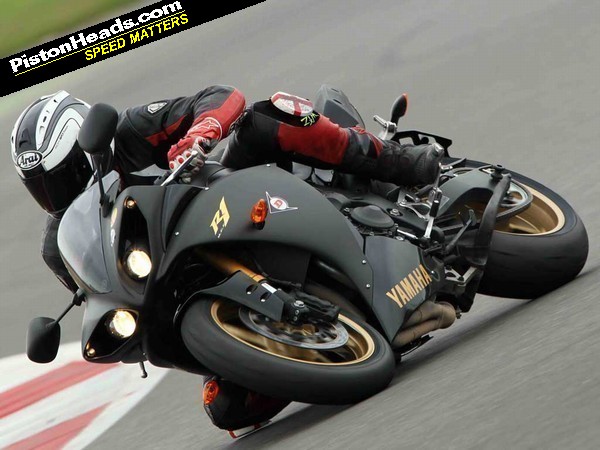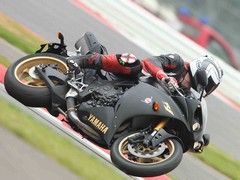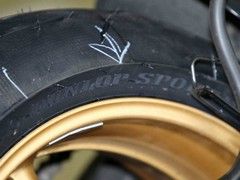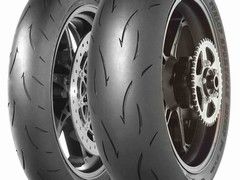Dunlop's track day rubber: PH2
It's black, it's round, it keeps you on the ground ... it's Dunlop's latest road legal track day tyre

Track tested
A road legal race tyre, this year the D212 GP Pro won all four of its TTs with Michael Dunlop riding the Supersport, Superstock and Superbike. Technically it also took the Senior TT with John McGuinness, though not in the same format. According to Dunlop, the firm's Superbike slick, the KR106/108, is basically a D212 GP Pro minus its tread pattern. During the final stages of manufacture the tread pattern is imprinted on the tyre when it is going through the vulcanization stage. Up until that point there is no difference between a slick and the road tyre. So it's fair to say this tyre has some performance credibility. So what's new?
Compared with the older D211, the new D212 front tyre has a less rounded and sharper profile as well as a 20 per cent stiffer carcass, while the tread uses Dunlop's multi tread (MT) technology. Before the tyre is cooked to harden it the 'rubber' is extruded onto the tyre in a continuous run of compound a bit like putting string on a bobbin.
By varying this compound Dunlop can give a tyre several different compounds of rubber across its surface, which is what happens in race tyres when riders need a soft compound on one side and harder on the other to suit a left or right handed circuit. The D212 front has two compounds, softer on either edge and a harder central compound, which is exactly as you would expect.
The rear is also a multi-compound construction with a harder central area and softer shoulders but also a third layer under the central compound area to improve stability and durability. However, unlike the front tyre, the rear also contains Dunlop's N-Tec system. N-Tec is a layer of material that allows the tyre to run lower pressures than normal while retaining its shape. The lower the pressure, the more surface area and therefore grip the tyre has when under power. Why isn't this used on the front? Dunlop has found the deformation affects the bike's handling so at the moment it is only used on rears. The rear tyre we tested was run at around 19psi, around half of the 42psi you get on a normal road tyre, although you would deflate this slightly for track use to probably around the 32psi area.
Sticky situation
Although the D212 is available in four front compounds and five rears, Dunlop armed us with middle of the range compounds as one and two are basically qualifying tyres and the only thing I was qualifying for was the sprint to bacon buttie seller. So, faced with Silverstone's full international circuit and a cross-plane crank R1, off I went.
Even while trying to learn the circuit the first thing I noticed about the D212 was its stability. Usually the more aggressive profile of a race orientated tyre causes the bike to become a bit unstable, or at least more prone to shaking its head out of corners or on a straight. Silverstone has several very long straights and the R1 remained rock solid without a hint of instability here and on fast corner exits under power, which was very impressive considering the sharper profile when compared to the older D211. And then there was the feeling from the rear.
You can certainly feel the rear has less pressure in it, but it doesn't affect the handling in a bad way. To me it seemed as if the tyre was softening any bumps out in the track and cushioning the ride slightly. As you would expect from a track tyre when you open the throttle the Dunlop digs in and grips like crazy, but for me it was the feeling of flexibility in the carcass over bumps that surprised me the most.
After a few sessions and with a vague idea where I was going I started to push a bit harder on Silverstone's corners. With the bike held on its ear through the long left then right of Luffield the Dunlops provided huge amounts of side grip, allowing me to hold the bike down before aiming at the final marker on the inside of Woodcote and firing out onto the start/finish straight. Having watched Cal slide it out of there in WSB and MotoGP I was pretty glad to be in no danger of repeating his sideways heroics, despite having the R1's throttle on the stop.
Earlier in the day one of the Dunlop technicians warned me that the front's sharp profile may make the bike feel as if it was flopping onto its side rather than rolling as you get on a road tyre. To be honest I didn't get this feeling at all and while the R1 certainly seemed to turn quickly, I wouldn't have said it flopped over.
How much, how long?
Dunlop reckons you are probably looking at around £320 a set for the D212 GP Pro, which is about £100 more than a set of 'road' tyres. This extra cost is due to the fact that every D212 is hand-built by the Dunlop race department, which comes at a cost. If you are serious about your track days, or race, the D212GP Pro is an incredibly impressive tyre and certainly performed far better than me. Dunlop estimates track riders should get about three track days out of a set and after riding six sessions around Silverstone mine looked to still be in pretty good condition. Maybe I wasn't trying hard enough, bringing us full circle to the whole talent, terror threshold and manhood thing...
Gassing Station | Biker Banter | Top of Page | What's New | My Stuff







